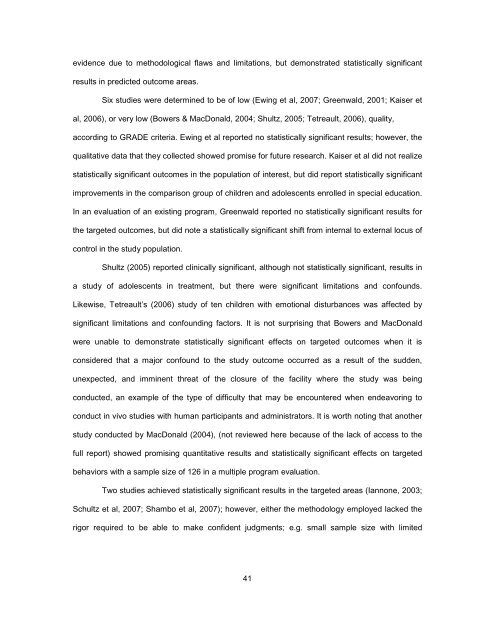A SYSTEMATIC REVIEW OF THE EFFECTS OF PSYCHOTHERAPY ...
A SYSTEMATIC REVIEW OF THE EFFECTS OF PSYCHOTHERAPY ...
A SYSTEMATIC REVIEW OF THE EFFECTS OF PSYCHOTHERAPY ...
You also want an ePaper? Increase the reach of your titles
YUMPU automatically turns print PDFs into web optimized ePapers that Google loves.
evidence due to methodological flaws and limitations, but demonstrated statistically significant<br />
results in predicted outcome areas.<br />
Six studies were determined to be of low (Ewing et al, 2007; Greenwald, 2001; Kaiser et<br />
al, 2006), or very low (Bowers & MacDonald, 2004; Shultz, 2005; Tetreault, 2006), quality,<br />
according to GRADE criteria. Ewing et al reported no statistically significant results; however, the<br />
qualitative data that they collected showed promise for future research. Kaiser et al did not realize<br />
statistically significant outcomes in the population of interest, but did report statistically significant<br />
improvements in the comparison group of children and adolescents enrolled in special education.<br />
In an evaluation of an existing program, Greenwald reported no statistically significant results for<br />
the targeted outcomes, but did note a statistically significant shift from internal to external locus of<br />
control in the study population.<br />
Shultz (2005) reported clinically significant, although not statistically significant, results in<br />
a study of adolescents in treatment, but there were significant limitations and confounds.<br />
Likewise, Tetreault’s (2006) study of ten children with emotional disturbances was affected by<br />
significant limitations and confounding factors. It is not surprising that Bowers and MacDonald<br />
were unable to demonstrate statistically significant effects on targeted outcomes when it is<br />
considered that a major confound to the study outcome occurred as a result of the sudden,<br />
unexpected, and imminent threat of the closure of the facility where the study was being<br />
conducted, an example of the type of difficulty that may be encountered when endeavoring to<br />
conduct in vivo studies with human participants and administrators. It is worth noting that another<br />
study conducted by MacDonald (2004), (not reviewed here because of the lack of access to the<br />
full report) showed promising quantitative results and statistically significant effects on targeted<br />
behaviors with a sample size of 126 in a multiple program evaluation.<br />
Two studies achieved statistically significant results in the targeted areas (Iannone, 2003;<br />
Schultz et al, 2007; Shambo et al, 2007); however, either the methodology employed lacked the<br />
rigor required to be able to make confident judgments; e.g. small sample size with limited<br />
41
















